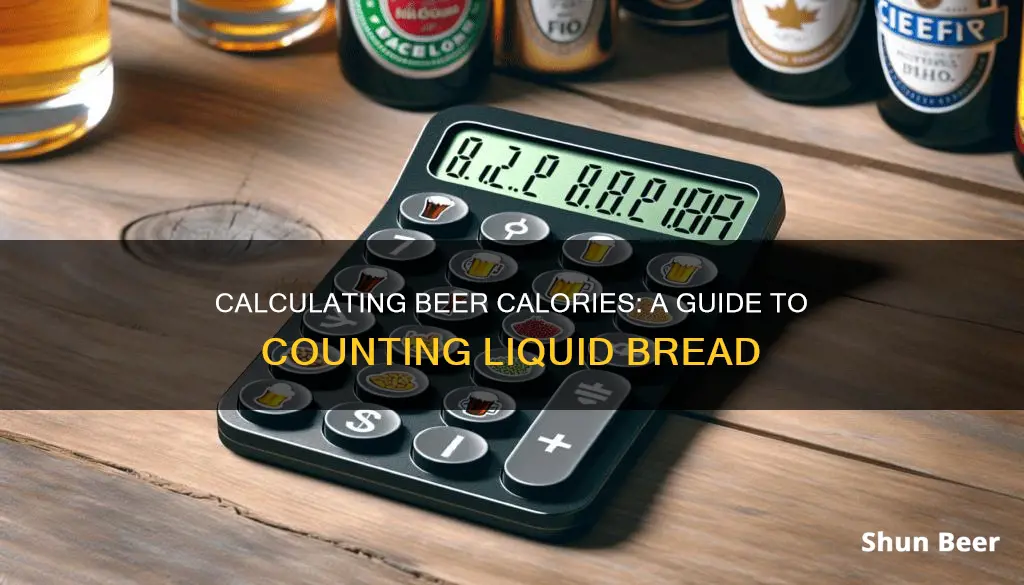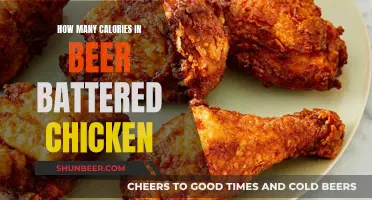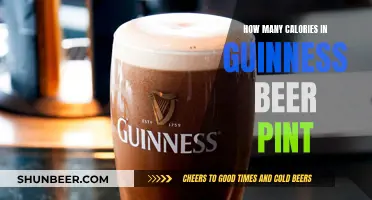
Beer is a food item and contains components that provide an energy value, or calories, to the consumer. The methods used to calculate energy value vary depending on the sources of caloric information. However, the values specified by the American Society of Brewing Chemists are generally considered close enough to be adopted. Beer contains protein, sugars, carbohydrates, and ethanol, all of which contribute to its calorie content. The calorie value of beer is very high, and a 12-ounce serving of beer contributes the same calories as four cookies. The higher the alcohol content, the higher the calories. Additionally, alcohol increases your appetite, leading to the accumulation of fat in the body.
| Characteristics | Values |
|---|---|
| Calories from | Alcohol, Carbohydrates, Protein, Sugars, Ethanol |
| Formula | ABV% x 2.5 x ounces of beer |
| ABV | Alcohol by Volume |
| Low-calorie beers | 4.5% or less |
| High-calorie beers | 6% or higher |
What You'll Learn

Calories from carbohydrates and alcohol
The calories in beer come from two main sources: carbohydrates and alcohol. The sugar extracted from barley and grains is what causes beer to ferment, and the more sugar present, the more alcohol is produced, and therefore the more calories there will be. The longer chains of carbohydrates that cannot be broken down by yeast remain in the beer and contribute to the overall calorie count.
The general rule is that a beer will derive about 60% of its calories from alcohol and the remaining 40% from carbohydrates. However, this can vary depending on the style of beer and the brewer. For example, a lager with 4.5% ABV in a 12-ounce serving will have approximately 135 calories, while a barrel-aged stout with 10.5% ABV in the same serving size will have about 315 calories.
The specific gravity of the beer, which is influenced by the mineral content, also plays a role in determining the final calorie count. The higher the alcohol content, the higher the calories in the beer. Additionally, the colour of the beer is not a reliable indicator of its calorie content, as darker beers do not necessarily have higher calories. Low-calorie beers tend to be lighter in colour due to the reduced use of grains during brewing, resulting in lower carbohydrate and alcohol content.
To calculate the calories from alcohol and carbohydrates in a 12-ounce serving of beer, you can use the following formulas:
Calories from Alcohol = 1881.22 * Final Gravity * (Original Gravity - Final Gravity) / (1.775 - Original Gravity)
Calories from Carbohydrates = 3550 * Final Gravity * ((0.1808 * Original Gravity) + (0.8192 * Final Gravity) - 1.0004)
The total calories in the beer are then calculated by adding the values obtained from these two equations.
Farmery Beer: Calorie Count and Nutrition Facts
You may want to see also

ABV and calories
The ABV (alcohol by volume) of a beer is a measure of the amount of alcohol in a beer, and it is usually located on the can or bottle. It is the most significant factor in determining the calorie content of a beer. The higher the ABV, the more calories in your beer. This is because alcohol contains calories; each gram of alcohol contains about seven calories. So, the more alcohol a beer contains, the more calories it will have. For example, a 12-ounce serving of a 5% ABV beer will contain around 150 calories, while a 12-ounce serving of an 8% ABV beer will contain about 200 calories.
The ABV of a beer can be used to calculate the number of calories it contains. The formula for this calculation is:
Beer calories = ABV% x 2.5 x ounces of beer
For example, if your beer is 12 ounces and 5% ABV, it has about 150 calories.
In addition to alcohol content, other factors that impact the calorie content of beer include residual sugars, the type and amount of malt used, and the overall brewing process. Beers with more residual sugars will have a higher calorie content, as will beers brewed with a higher percentage of malt, as more residual sugars will be left in the beer after fermentation.
However, it is important to note that the colour of a beer is not a useful signifier of its calorie content. Darker beers do not necessarily equate to high-calorie beverages.
Calories in Miller Chill Beer: Nutritional Breakdown
You may want to see also

Calculating calories in homebrewed beer
Calculating calories in home-brewed beer
The calories in beer come from the alcohol and carbohydrates in the drink. The alcohol is derived from the sugars in the barley and grains used to brew the beer. The more sugar that is present, the more alcohol there will be, and therefore the more calories.
To calculate the calories in a beer, you can use the following formula:
> Beer calories = ABV% x 2.5 x ounces of beer
For example, a 12-ounce beer with 5% ABV has about 150 calories.
If you want to calculate the calories in a home-brewed beer, you will need to know the original and final gravities of the beer in question. You can then use the following two equations to determine the total number of calories from alcohol and the total number of calories from residual carbohydrates, both of which rely on gravity readings:
> Calories from alcohol = 1881.22 * Final_Gravity * (Original_Gravity – Final_Gravity)/(1.775 – Original_Gravity)
> Calories from carbohydrates = 3550 * Final_Gravity * ((0.1808 * Original_Gravity) + (0.8192 * Final_Gravity) – 1.0004)
> Total calories = Calories from alcohol + Calories from carbohydrates
So, for example, if you have a pale ale with an original gravity of 1.054 and a final gravity of 1.010, you’d have a total of about 179 calories, with 116 calories coming from alcohol and 63 calories from residual carbohydrates.
UFO White Beer: Calories and Nutrition Facts
You may want to see also

Low-calorie beers
Beer is often associated with "empty calories", but it is possible to be healthy and still drink beer. The key is to be mindful of the type of beer you drink and how many you consume.
- Budweiser Select (2.4% ABV): 55 calories
- Molson Ultra (3% ABV): 70 calories
- Moosehead Cracked Canoe (3.5% ABV): 90 calories
- Sleeman Light (4% ABV): 90 calories
- Busch Light (4.1% ABV): 91 calories
- Labatt Premier (4% ABV): 92 calories
- Amstel Light (4% ABV): 95 calories
- Miller Lite (4.2% ABV): 96 calories
- Heineken Light (4.2% ABV): 97 calories
- Corona Light (3.7% ABV): 99 calories
- Yuengling Light Lager (3.8% ABV): 99 calories
- Coors Light (4.2% ABV): 102 calories
- Carlsberg Lite (4% ABV): 102 calories
- Bud Light (4.2% ABV): 103 calories
- Jester King Le Petit Prince (2.9% ABV): 75 calories
- Dogfish Head Slighty Mighty (4% ABV): 95 calories
- Lagunitas DayTime (4% ABV): 98 calories
- Lakefront Eazy Teazy (3.4% ABV): 99 calories
- Kona Kanaha Blonde Ale (4.2% ABV): 99 calories
- Guinness Draught Stout: 125 calories
When choosing a low-calorie beer, it is important to consider not only the calorie count but also the overall carbohydrate content and added sugars, especially in flavoured varieties. Additionally, keep in mind that low-calorie beers may still be high in alcohol, so it is recommended to limit consumption to 1-2 drinks per day.
Calories in Wild Craft Beer: Gourd's Gone Wild
You may want to see also

Beer and weight gain
Beer is a beloved beverage for many, but it's no secret that it's also associated with weight gain. So, what's the deal? Can you enjoy a beer or two without expanding your waistline? Let's explore the relationship between beer and weight gain, and offer some strategies to minimise the impact on your fitness goals.
Calories in Beer
The main sources of calories in beer are carbohydrates and alcohol. These calories are derived from the fermentation process, where yeast breaks down sugars in the barley and grains, resulting in alcohol and carbon dioxide. The higher the alcohol content, the more calories a beer will generally contain. This is reflected in the Alcohol by Volume (ABV) percentage, which indicates the amount of alcohol in a standard drink.
Calculating Beer Calories
A simple formula to estimate the calories in a beer is:
> Calories = ABV% x 2.5 x ounces of beer.
For example, a 12-ounce beer with 5% ABV would contain approximately 150 calories. It's worth noting that this formula provides an estimate, and the actual calorie content can vary depending on other factors in the brewing process.
Beer Belly Blues
The phrase "beer belly" is commonly used to describe excess fat accumulation in the abdominal area, often associated with regular beer consumption. While it's true that beer can contribute to weight gain, it's not the only factor at play. Consuming an excessive amount of calories from any source can lead to weight gain, and beer is no exception.
Strategies for Beer Lovers
If you're a beer enthusiast, there's no need to give up your favourite drink completely. Here are some strategies to minimise the impact on your waistline:
- Moderation: As with anything, moderation is key. Enjoying a beer or two in moderation won't derail your fitness goals. It's when consumption becomes excessive that it can lead to weight gain.
- Low-Calorie Beers: Opting for low-calorie beers can be a smart choice. These beers tend to have a lower ABV and fewer carbohydrates, resulting in fewer overall calories.
- Food Choices: Consider the food you pair with your beer. If you know you'll be indulging in a high-calorie brew, opt for a lighter meal to balance your overall calorie intake.
- Flavourful Low-ABV Beers: You might be surprised to find that some low-ABV beers pack a lot of flavour. Seek out craft beers that offer a satisfying taste experience without the high calorie count.
- Sip and Savour: Instead of chugging your beer, try sipping and savouring it slowly. This way, you can make one beer last longer and reduce the overall number of calories you consume.
Final Thoughts
While beer can contribute to weight gain, it's not the sole culprit. By being mindful of your overall calorie intake, making smart choices, and enjoying beer in moderation, you can strike a balance between indulging in your favourite brew and maintaining a healthy weight.
So, go ahead and pour yourself a cold one—just remember to do so in moderation and be mindful of your overall fitness goals.
Guinness Beer Calories: Pint-Sized Pleasure or Calorific Conundrum?
You may want to see also







